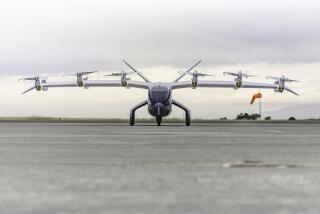Above the Fray : Transportation: While most commuters are battling stop-and-go traffic and in-your-face pollution, these travelers are getting to and from work on a <i> real </i> freeway. They say an airplane definitely is a cut above a car pool.
Like thousands upon thousands of far-flung Los Angeles-area commuters, Norco resident Don Hanson climbs into the driverâs seat every morning, starts his engine and heads out on the long ride into L.A.
Unlike other commuters, however, Hanson doesnât have to worry about stop-and-go traffic. In fact, Hanson maintains a constant speed throughout the 62-mile trip--about 140 m.p.h., enough to get him to his destination in 20 minutes.
Hanson is not a car-driving commuter. Heâs an airplane-driving commuter who, with his fellow âplane-poolers,â sails merrily along in his single-engine Grumman Cheetah, 2,000 or 3,000 feet above the nail-biting, knuckle-chewing, steering-wheel-pounding frustration that the rest of us call rush hour.
âIt really is the way to go,â says Hanson, 58, an executive for Hughes Corp. in El Segundo who has been commuting via his own airplane for the past seven years. A pilot for 40 years, Hanson adds: âFlying is very special, and I consider myself very fortunate to be able to do it every day.â
Hansonâs plane-pooling group is part of an increasing number of commuters who fly into Hawthorne Municipal Airport instead of fighting freeway traffic. The numbers vary from day to day, depending on the weather, but airport manager Bob Trimborn estimates there are at least a dozen small airplanes that make regular daily plane-pool trips into the airport from Riverside County, San Bernardino County and other distant areas.
âI think that in the future, as car traffic gets increasingly congested, (plane pooling) will get more and more popular,â Trimborn says.
So does Paul Rost, a Northrop Aircraft Division manager who flies in from Redlands every day in his Beechcraft Sundowner single-engine plane.
âI feel sorry for them,â Rost says of freeway-commuters, as two Northrop colleagues and fellow plane-poolers, Crow Wilson and Larry McCallon, nod their heads in agreement. âWeâre probably the only commuters in Los Angeles who actually enjoy getting to and from work.â
Plane-pooling works just like car-pooling, except that it involves a plane and takes a lot less time. The pilot owns the plane, and his plane-poolers, usually co-workers, share expenses.
Every morning the plane-poolers meet at the municipal airport near their homes--Chino Municipal Airport, in the case of Hansonâs group--climb aboard the plane and land 20 or 30 minutes later in Hawthorne. Then, if necessary, they climb into a car the pilot keeps parked by the runway--usually a car of the clunker variety--and drive to their workplace. Hansonâs resident airport car is a 1973 Mercury Comet.
The costs of plane-pooling are surprisingly low, if you donât count the $25,000 to $30,000 cost of even a used plane, plus relatively high maintenance costs. Hansonâs Cheetah burns seven gallons of aviation fuel per round trip, at $1.75 a gallon; aircraft parking at Hawthorne is $2.50 a day, and car parking is $25 per month. Hansonâs plane-poolers pay him a flat rate of $50 per week for a seat in the four-seat aircraft.
But for flying commuters, as for most commuters, time is at least as important as money.
âI used to ride in a van pool,â says Ontario resident Steven Hughes, 31, a security specialist at Northrop Corp. who for the past six months has been one of Hansonâs regular plane-poolers. âBut it took about two hours. Then somebody told me about the plane pool. My wife encouraged me to try it, because sheâd see how stressed out I was from the drive back and forth. I was reluctant at first, because Iâd never been in a small plane before. But once I got airborne I wasnât nervous at all.â
âHe felt a lot better when we showed him all the traffic he was missing,â says John Bramlett, 32, an administrator at Hughes and another of Hansonâs plane-poolers. Bramlett, like Hanson a Norco resident, said that for the first two years he lived in Norco he drove back and forth to L.A., spending as much as four hours a day in his pickup truck.
Himself a licensed pilot, Bramlett has been plane-pooling with Hanson for more than two years and wouldnât commute any other way.
âIf it werenât for this Iâd have to seriously think about finding another job,â he says.
âThe best thing for me is the time saving,â says Donna Scharff, 35, a Lake Elsinore resident who has been plane-pooling for three years. (Scharff, who usually flies in from Corona in another plane-pool, was riding with Hanson last week because her regular plane-pooling aircraft was undergoing maintenance.)
Before she started plane-pooling, Scharff says, she had to be in bed by 8 p.m. every night so she could get up at 3:30 a.m. to make the 100-mile commute.
âI have three children,â Scharff says, âso for me this (plane-pooling) is an opportunity to get home at a regular hour and spend time with my children.â
But what about safety? In addition to being small and cramped--arenât small planes dangerous?
Plane-poolers generally scoff at the notion that plane-pooling is more dangerous than driving.
âLook at all the people out there who are driving around with hardly any training,â Bramlett says. âNothing like the training and retraining a pilot gets. Think about how many car crashes there are every day on the freeways.â
He pauses a moment and then adds, âIâll grant you, in a car you can pull over to the curb if thereâs a problem.â
Still, Bramlett and the other plane-poolers seem convinced that flying to work is the way to go. Theyâre happy to leave the driving to somebody else.
More to Read
Sign up for The Wild
Weâll help you find the best places to hike, bike and run, as well as the perfect silent spots for meditation and yoga.
You may occasionally receive promotional content from the Los Angeles Times.






